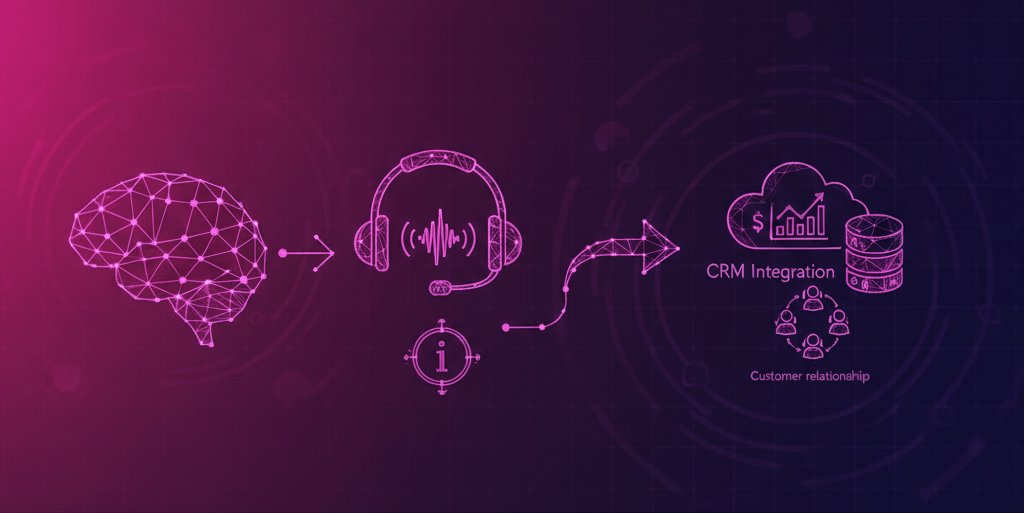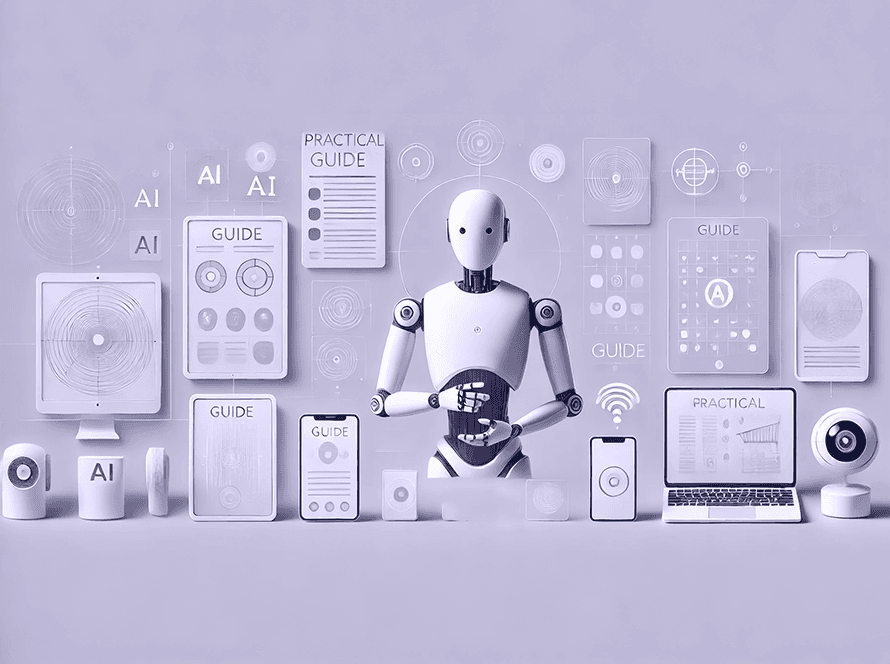“Your next AI Caller with CRM Integration must use deep, real-time two-way sync to automatically log activities, enrich contact data, and eliminate manual entry.”
You’ve seen the demos. An AI voice, impossibly human, breezes through a qualifying call, books a meeting, and hangs up. The promise is intoxicating: a world where your sales team focuses only on closing, not on the tedious grind of cold calling. So you invest in an AI calling platform. For a week, it feels like magic. But then, a creeping dread sets in.
Your sales reps are asking questions. “Where are the notes from the AI’s call with Acme Corp?” “Did the AI update the lead status for that prospect who asked for a call back in three months?” You check your Customer Relationship Management (CRM) platform, the supposed single source of truth for your entire revenue operation. It’s a ghost town. The contact records are blank. The call activities are missing. The lead statuses are stale.
Suddenly, your futuristic AI caller feels less like a strategic asset and more like a disconnected gadget, creating a second, invisible database of interactions. You’ve saved your team’s time on the phone, only to make a massive data entry nightmare that undermines your entire sales process.
This is the critical, often overlooked—until it’s too late— reality of adopting sales AI. The magic isn’t in the voice; it’s in the data. And if that data doesn’t flow instantly, automatically, and intelligently into your CRM, you haven’t bought a solution—you’ve purchased a new problem. This is why your next, and frankly, your first AI caller with CRM integration cannot simply have a basic connection; it must have a deep, two-way, foundational integration. It’s not a feature; it’s the entire point.
The Silent Killer of Revenue: The CRM Data Gap
Before we dive into the solution, let’s take a moment to dissect the problem. Your CRM is the heart of your sales organization. It tracks every touchpoint, informs every forecast, and guides every strategic decision. When its data is incomplete or inaccurate, the entire organism suffers.
Manual data entry is the primary disease. We ask our highly paid, highly skilled sales representatives to spend hours each week performing administrative tasks. They become glorified data clerks, typing up call notes, updating dropdown menus, and scheduling follow-up tasks.
Think about the real cost of this:
- Lost Details: A representative finishes a 15-minute call during which a prospect mentions a key competitor, a specific pain point, and a budget cycle timeline. By the time they update the CRM (often at the end of the day or week), they may only recall the primary outcome. Those crucial, nuanced details are lost forever.
- Inconsistent Data: Rep A logs a “Not Interested” call with detailed notes. Rep B just changes the lead status and moves on. Rep C forgets to log the call entirely. The result? You have no consistent data set to analyze why leads aren’t converting.
- Delayed Actions: A prospect says, “This is great, but call me back next quarter.” If the rep doesn’t immediately create a task and update the record, that lead falls into a black hole. It’s a guaranteed lost opportunity.
- Inaccurate Forecasting: Sales managers pull reports based on CRM data. If half the call activities are missing and lead statuses are weeks out of date, your forecast is pure fiction. You’re flying blind, making decisions about hiring, quotas, and strategy on a foundation of guesswork.
This isn’t the fault of lazy reps. It’s the fault of a broken workflow. AI callers that operate outside the CRM ecosystem amplify this problem exponentially. They can make hundreds or thousands of calls a day, creating an ocean of valuable data that never reaches your system of record. It’s a recipe for chaos.
The Great Divide: Understanding Shallow vs. Deep Integration
The term “CRM integration” is used so frequently that it has lost much of its meaning. Many software vendors will claim they “integrate” with your CRM when, in reality, they offer a connection that is flimsy and superficial. It’s crucial to understand the difference between shallow and deep integration.
Shallow Integration: The Illusion of Connectivity
Shallow integration is like having a one-way street with a toll booth. Data may move in one direction, but it’s a manual and clunky process. It appears well on a feature list, but it falls short in practice.
Characteristics of shallow integration include:
- Click-to-Call: You can click a button in your CRM to initiate a call through the AI platform. This is a minor convenience, but it does nothing to bring the call outcome back into the CRM.
- Manual Data Push: After a block of calls, you can select a batch of records and manually push a generic “call attempted” activity log to the CRM. This is better than nothing, but it lacks automation and specific details.
- One-Time Contact Import: You can upload a CSV file of contacts from your CRM into the AI caller. However, any changes made to the CRM after that import are not reflected in the calling tool, and vice versa. The two systems are immediately out of sync.
Shallow integration doesn’t solve the core problem of manual data entry. It still requires the sales rep to act as the middleman, translating the results of the AI’s work back into the CRM. It’s a leaky bucket that provides a false sense of security while critical customer intelligence spills out onto the floor.
Deep Integration: The Central Nervous System
Deep integration is fundamentally different. It’s not a feature bolted on; it’s the architectural foundation of the platform. Think of it as a central nervous system, creating a real-time, two-way conversation between your AI caller and your CRM. Information flows freely and automatically in both directions, enriching both systems simultaneously.
This is the standard you must demand. An AI caller with CRM integration that is truly deep will perform these functions without any human intervention:
- Automated, Real-Time Activity Logging: The instant an AI-powered call concludes, a new activity is created in the correct contact record in your CRM. This isn’t just a note that a call happened. It includes the call recording, a full transcript, an AI-generated summary of the conversation, the call duration, and the specific outcome or disposition (e.g., “Meeting Booked,” “Wrong Person,” “Budget Issue”).
- Dynamic Record Updating: The integration goes beyond just logging an activity. It intelligently updates fields on the contact or deal record. If the AI books a meeting, the lead status automatically changes from “Contacting” to “Meeting Scheduled.” If the AI disqualifies a lead, the record is updated accordingly.
- Two-Way Data Synchronization: This is the game-changer. The AI doesn’t just write to the CRM; it reads from it. Before making a call, the AI can retrieve the latest information from the CRM record, including notes from previous conversations, recent marketing email opens, or customer support tickets. This enables the AI to engage in a more contextual and relevant discussion. This two-way CRM sync is a non-negotiable.
- Workflow Triggers: Deep integration enables the AI’s call outcome to trigger automated workflows within your CRM. A “Meeting Booked” disposition can automatically trigger an email confirmation sequence, create a task for the account executive to prepare for the meeting, and add the prospect to a specific list. This is true sales automation and CRM working in perfect harmony.
When you achieve this level of integration, the AI caller becomes a seamless part of the system. It becomes a valid extension of your CRM and a perfectly compliant member of your sales team—one that never forgets to update its records.
The Strategic Payoff: Four Pillars of Deep Integration’s Value
Moving beyond “saving time” reveals the profound strategic impact of a deeply integrated AI caller. This isn’t just about efficiency; it’s about building a smarter, more predictable, and more effective revenue engine.
Pillar 1: Forging the Single Source of Truth for a Unified Customer View
In most organizations, customer data is fragmented. Marketing has its interaction data in one system, sales has its notes in the CRM, and customer support has its tickets in another. This creates a fractured and incomplete picture of the customer journey.
A deeply integrated AI caller helps demolish these silos. Every single call attempt, conversation, and outcome is logged directly on the contact record.
Imagine a sales manager preparing for a pipeline review. They can open any opportunity and see not just the human-led activities, but a complete history of every AI call. They can read the AI’s summary of the initial qualifying call, see that the prospect mentioned a key competitor, and listen to the recording to understand their exact tone and priorities.
Now, imagine an account manager taking over a new client. They can review the entire history in the CRM, including the very first AI-powered conversation that sparked their interest. This creates a unified customer view, ensuring that anyone in your organization can access the complete, unabridged story of every customer relationship. There are no more data gaps or “he-said, she-said” moments. The CRM becomes the undisputed, 100% accurate source of truth.
Pillar 2: Achieving Perfect CRM Data Hygiene, Automatically
Data hygiene is a constant battle for RevOps and sales leaders. Inaccurate and incomplete data lead to bad reports, misguided strategies, and wasted effort. You can run training sessions and plead with your reps, but as long as the process is manual, it will be imperfect.
Deep integration solves this problem at its root. It enforces perfect data discipline through automation. The automated CRM data entry ensures that:
- Every call is logged: No exceptions. 100% of outreach activity is captured.
- Data is structured and consistent: You define the dispositions (“Meeting Booked,” “Voicemail,” “Not Interested – Timing”). The AI uses these dispositions every single time. This structured data is a goldmine for analysis. You can efficiently run reports to see why you’re winning or losing deals at the top of the funnel.
- Information is rich and detailed: You get more than just a disposition. You receive the summary, transcript, and recording. This qualitative data adds context to the quantitative data, helping you understand the “why” behind the numbers.
This commitment to improve CRM data hygiene means your reports are finally trustworthy. Your dashboards accurately reflect reality, allowing you to make decisions with a high degree of confidence.
Pillar 3: Enabling Hyper-Personalized Follow-up and Smarter Conversations
Personalization is key to modern sales, but it’s tough to do at scale. A deeply integrated AI caller powers personalization in a powerful feedback loop.
First, the AI uses data from the CRM to personalize its own outreach. It can reference the prospect’s industry, title, or past interactions to make the initial conversation more relevant.
But the real magic happens next. The AI executes the call and then funnels a wealth of new information back into the CRM. This is AI for CRM enrichment in its purest form. The AI captures nuances, pain points, and buying signals that are now permanently stored in the contact record.
Now, when your human sales rep takes over for the discovery call or demo, they are armed with incredible intelligence. Before the meeting, they can read the AI’s call summary in the CRM and know exactly what topics to focus on. They can say things like, “I saw in the notes from your first call that you were concerned about implementation time. Let’s start by addressing that head-on.”
This creates a seamless and intelligent customer experience. The prospect doesn’t have to repeat itself. The sales rep appears incredibly well-prepared and attuned to their needs. This is how you streamline sales workflow with CRM data, moving from a transactional process to a consultative one.
Pillar 4: Igniting Your Sales Automation Engine with Intelligent Triggers
The ultimate goal of a modern sales stack is automation that feels personal. Deep integration allows the outcomes of your AI calls to become powerful triggers for your entire tech stack.
Because the AI automatically updates fields and dispositions in the CRM, you can build workflows that fire based on those changes. This is where you can trigger calls from CRM status changes, or more powerfully, trigger CRM workflows from call outcomes.
Consider these automated workflows, all powered by the AI’s call data:
- Outcome: “Meeting Booked”
- Trigger: Automatically send a calendar invite and a confirmation email from the assigned sales rep.
- Trigger: Create a task in the CRM for the representative to research the prospect’s company 24 hours before the meeting.
- Trigger: Add the prospect to a “pre-meeting nurture” email sequence that shares a relevant case study.
- Outcome: “Not Interested – Bad Timing”
- Trigger: Automatically update the lead status to “Nurture.”
- Trigger: Enroll the contact in a 6-month, low-touch email campaign that keeps your brand top of mind.
- Trigger: Create a task for the AI to re-engage the prospect in 180 days.
- Outcome: “Voicemail”
- Trigger: Automatically enroll the prospect in a multi-touch cadence that attempts another call in 2 days, followed by an email.
This level of automation ensures that no lead is ever dropped and every follow-up is perfectly timed and context-aware. Your human reps are freed up to focus on high-value conversations, secure in the knowledge that the system is taking care of the rest.

SalesCloser.ai: Built on a Foundation of Deep Integration
Understanding the theory is one thing; seeing it in action is another. This philosophy of deep, foundational CRM integration isn’t just a hypothetical ideal. It’s the core principle behind SalesCloser.ai. We didn’t build an AI caller and then try to tack on a CRM connection. We built a platform designed from the ground up to be a native, intelligent extension of your CRM.
Here’s how SalesCloser.ai embodies deep integration:
- Seamless Two-Way Sync: When you connect SalesCloser.ai to your CRM (such as HubSpot or Salesforce), it establishes a persistent, two-way data connection. Our platform can read custom fields, lead statuses, and existing activity history to inform its calling campaigns. Then, as it makes calls, it instantly writes back a rich set of data.
- Comprehensive Data Logging: For every SalesCloser.ai call, data is automatically logged to the CRM. This isn’t just a single line of text. We log:
- The Call Disposition (fully customizable to match your sales process)
- An AI-Generated Call Summary (a concise, bulleted list of key points)
- The Full Call Transcript
- A Link to the Call Recording
- The exact date, time, and duration of the call.
- Intelligent Field Updates: SalesCloser.ai doesn’t just add notes; it changes the state of your CRM. When a meeting is booked, our integration can automatically update the lead stage, change the contact owner, and create the event on the representative’s calendar, linking it to the correct contact and deal record. This ensures your pipeline data is always 100% accurate and up-to-date.
- Automated Task Creation: The ability to log call outcomes automatically extends to creating next steps. If a prospect requests a piece of content or a follow-up on a specific date, SalesCloser.ai can create a task in the CRM and assign it to the correct representative, ensuring nothing is ever missed.
With SalesCloser.ai, your CRM is no longer a historical archive of what your reps remembered to type in. It becomes a living, breathing chronicle of every single interaction, captured with perfect fidelity and instantly accessible to your entire team. Your AI agent doesn’t just make calls; it diligently performs the administrative work that ensures your entire sales process runs on clean, reliable, and actionable data.
Your CRM Is Too Valuable to Be Left in the Dark
The allure of AI in sales is undeniable. But the most significant risk is investing in a tool that operates in a vacuum, creating more work and data chaos than it solves.
Shallow, one-way integrations are a trap. They promise efficiency but deliver fragmentation. They force your team to straddle two different systems, manually bridging the gap and letting crucial intelligence fall through the cracks.
Deep, two-way integration is the only path forward. It transforms your AI caller from a simple autodialer into the most reliable and data-conscious member of your team. It makes your CRM smarter. It makes your forecasts more accurate. It makes your sales reps more prepared and effective.
So, as you evaluate your options, ask the tough questions. Don’t just ask, “Do you integrate with my CRM?”
Instead, ask:
- “Do you provide a real-time, two-way sync?”
- “What specific data points are automatically logged after every single call?”
- “Can your platform automatically update lead statuses and other record fields based on call outcomes?”
- “Can you call outcomes from your AI trigger automated workflows within our CRM?”
Your next AI caller shouldn’t just talk to your prospects. It must have a constant, intelligent conversation with your CRM. Don’t settle for anything less. The future of your sales data depends on it.
Frequently Asked Questions (FAQs)
Q1: What is the main difference between a shallow and a deep AI caller with CRM integration?
The simplest way to think about it is in terms of direction and automation. A shallow integration is typically one-way and manual. It may allow you to click a button to initiate a call (CRM to caller) or manually log a generic activity after the fact (caller to CRM). A deep integration is two-way, real-time, and fully automated. It both reads data from the CRM to inform calls and instantly writes rich, detailed call outcomes back to the CRM without any human intervention, even updating fields and triggering workflows.
Q2: Is setting up a deep CRM integration complicated and time-consuming?
It shouldn’t be. Modern platforms like SalesCloser.ai are designed for ease of use. Typically, setup involves authenticating your CRM account with a few clicks, mapping your call dispositions to the relevant fields in your CRM, and defining a few simple rules. A good provider will have a streamlined onboarding process to get you up and running in a single session, not weeks.
Q3: How does this deep integration impact data security and privacy?
Data security is paramount. A reputable AI calling platform will use secure, encrypted connections (like OAuth 2.0) to link to your CRM. The integration should only request permission to access the data it needs to function. Ensure the provider is compliant with major data privacy regulations, such as GDPR and CCPA. At SalesCloser.ai, we treat your CRM data with the same level of security and confidentiality as you do.
Q4: Can the AI understand our company’s specific sales process and terminology to log outcomes correctly?
Absolutely. This is a key feature of a sophisticated platform. Deep integration isn’t about forcing you into a generic workflow. You should be able to customize the call dispositions within the AI platform to perfectly match the lead stages and terminology you already use in your CRM. The goal is for the AI to adapt to your process, not the other way around.
Q5: Will my sales reps feel like the AI is replacing them or just creating more data for them to look at?
This is a common concern, but the reality is the opposite. By handling top-of-funnel prospecting and tedious data entry, the AI frees up reps to do what they do best: build relationships, conduct in-depth discovery, and close deals. The rich data provided by the AI in the CRM isn’t more work; it’s better preparation. Reps walk into meetings more informed and confident, leading to higher win rates and less time spent on low-value administrative tasks.
Q6: We are a small business. Is an AI caller with deep CRM integration only for large enterprises?
Not at all. In fact, small and medium-sized businesses can benefit enormously. With smaller teams, every minute of a salesperson’s time is precious. Automating prospecting and data entry allows a small team to punch well above its weight, ensuring that even with limited resources, their CRM data is pristine and no leads ever fall through the cracks. It levels the playing field, allowing them to implement the kind of disciplined, data-driven sales process that was once only possible for large enterprises.








